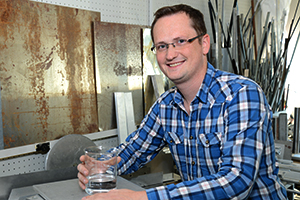
Heavy metal contaminants in the water supply can lead to developmental disabilities, organ damage and even cancer in humans. But new research being done at TCNJ points to a more effective, economical and environmentally friendly way to remove toxic metals from our water.
It turns out that alginate—a biopolymer derived from brown algae—is great at binding to metals. The only problem? Alginate dissolves in water. So Assistant Professor of Technological Studies Matthew Cathell and several of his students have been working on some pretty creative engineering that allows them to create alginate filters that hold up against the very thing they’re trying to clean.
Here’s how their technology works: the researchers dissolve a powdered form of alginate in an aqueous solution and then eject that solution through an electrical field. The process results in alginate nanofibers—some just 1/1000th the diameter of a human hair—that accumulate to form a porous, meshlike membrane. Calcium ions are then added to make the nanofibers insoluble in water. When contaminated water flows through the membrane, heavy metal ions bind to the alginate and can then be safely removed.
“Alginate’s ability to bind to metals has been well established,” says Cathell. “What’s novel about our technology is that we’re creating and using this fibrous form of alginate.”
There are numerous advantages to this type of application, says Cathell. For starters, unlike activated carbon filters (think Brita) the TCNJ water filters can be cleaned and reused. Also, they’re made from sustainable materials: Nature mass produces the brown algae from which alginate is derived. And the TCNJ filters are inexpensive to make: It cost the researchers just fractions of a penny to produce theirs.
Perhaps most interesting is that this technology is adaptable. Alginate can be chemically modified to bind to specific contaminants, so the potential exists to create filters tailored to specific heavy metals, says Cathell. So if, say, toxic hexavalent chromium is prevalent in an area, you could produce a filter that specifically binds to that particular molecule.
Allyson Salmon ’14, Joanna Papadopoulos ’13, Melissa Bradley ’12 have worked with Cathell on the project. The team has presented talks related to its work at two American Chemical Society (ACS) national meetings, most recently in San Francisco last summer.
“Our project seems to hit a universal chord,” says Cathell. “Everyone we meet understands the urgent significance of protecting and remediating our water resources, and everyone seems fascinated by these incredibly minute and beautiful fibers that we produce.”
